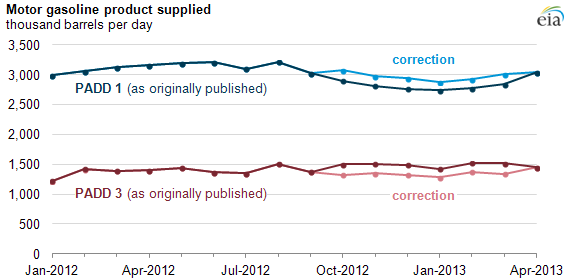
Petroleum products demand data revised at regional level

Republished: July 15, 2013, 10:30 a.m.: Text was modified to clarify content.
EIA has corrected estimates of regional motor gasoline consumption in key East and Gulf Coast markets, or PADD 1 and PADD 3, respectively. A recent revision to petroleum product movements in the Petroleum Supply Monthly (PSM) has increased the estimated consumption of gasoline in the East Coast and lowered the estimated consumption of gasoline in the Gulf Coast of the United States.
The data revision involves movements of motor gasoline as reported to EIA by one or more survey respondents. A decline in motor gasoline movements from PADD 3 to PADD 1 reported in the PSM began with data from October 2012. This coincided with Hurricane Sandy affecting the East Coast, which initially masked the misreported data. However, when the decline continued well after the storm's disruptions had ended, it was discovered that the data had been misreported by one of the respondents, and the data have been corrected.
Total PADD-level receipts (imports) of the product in question are an important variable in the product supplied calculation. Net receipts reflect the difference between receipts of that product from other PADDs and the movements out of the PADD (to other PADDs) by pipeline, tanker, rail, and barge. Overstating the net receipts in a given PADD would artificially inflate the product supplied for that PADD, while understating them would have the opposite effect.
The largest change in product movements was to gasoline, but other products were also affected, particularly distillate fuel oil. Corrected data for October-December 2012 will be reflected in the upcoming 2012 Petroleum Supply Annual (to be released this summer), while corrected data for January-March 2013 will be reflected in the 2013 Petroleum Supply Annual.